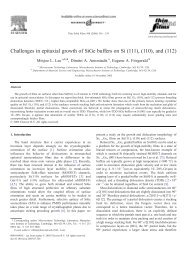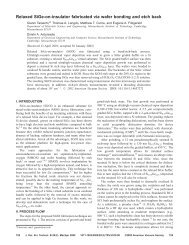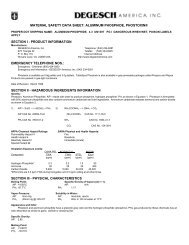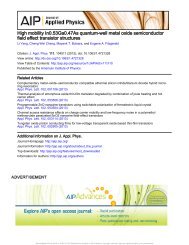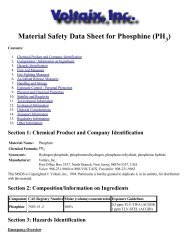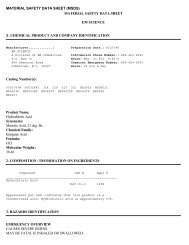Hydrofluoric Acid
Hydrofluoric Acid
Hydrofluoric Acid
Create successful ePaper yourself
Turn your PDF publications into a flip-book with our unique Google optimized e-Paper software.
Material Safety Data SheetAshland Chemical Co. Date Prepared: 12/10/97Date Printed: 06/21/99MSDS No: 308.0025481-006.004IHYDROFLUORIC ACID 49% SG__________________________________________________________________________1. CHEMICAL PRODUCT AND COMPANY IDENTIFICATIONMaterial IdentityProduct Name: HYDROFLUORIC ACID 49% SGGeneral or Generic ID: INORGANIC ACIDCompanyEmergency Telephone Number:Ashland Chemical Co. 1-800-ASHLAND (1-800-274-5263)P.O. Box 221924 hours everydayColumbus, OH 43216614-790-3333 Regulatory Information Number:1-800-325-3751__________________________________________________________________________2. COMPOSITION/INFORMATION ON INGREDIENTSIngredient(s) CAS Number % (by weight)-------------------------------------------- ------------- -------------WATER 7732-18-5 49.0- 53.0HYDROFLUORIC ACID 7664-39-3 49.0__________________________________________________________________________3. HAZARDS IDENTIFICATIONPotential Health EffectsEyeSkinCan cause permanent eye injury. Symptoms include stinging,tearing, redness, and swelling of eyes. Can injure the cornea andcause blindness.Both the liquid and vapor can cause severe burns which may not beimmediately painful or visible.SwallowingSwallowing this material may be harmful or fatal. Symptoms mayinclude severe stomach and intestinal irritation (nausea,vomiting, diarrhea), abdominal pain, and vomiting of blood.Swallowing this material may cause burns and destroy tissue in themouth, throat, and digestive tract. Low blood pressure and shockmay occur as a result of severe tissue injury.InhalationBreathing of vapor or mist is possible. Breathing this materialmay be harmful or fatal. Symptoms may include severe irritation
and burns to the nose, throat, and respiratory tract.Symptoms of ExposureNo dataTarget Organ EffectsRepeated, prolonged overexposure to inorganic fluoride compoundsmay result in increased bone density, fluorosis, digestivedisturbances, loss of weight, anemia, and diseases of the teeth.Developmental InformationNo dataCancer InformationNo dataOther Health EffectsNo dataPrimary Route(s) of EntryInhalation, Skin absorption, Skin contact.__________________________________________________________________________4. FIRST AID MEASURESEyesSkinIf material gets into the eyes, immediately flush eyes gently withwater for at least 15 minutes while holding eyelids apart. Ifsymptoms develop as a result of vapor exposure, immediately moveindividual away from exposure and into fresh air before flushingas recommended above. Seek immediate medical attention.Immediately flush contaminated skin with large quantities of coolwater for at least 15 minutes. Remove contaminated clothing. Assoon as possible apply 2.5% calcium gluconate gel to all affectedskin areas. The gel should be massaged into the affected skin bypersonnel wearing protective gloves to prevent skin contaminationduring first aid. Alternatively, affected areas may be soaked ineither iced 0.2% water solution of Hyamine 1622 or iced 0.13%water solution of Zephiran chloride. If Hyamine 1622 or Zephiranchloride solutions are not available, use an iced saturated watersolution of magnesium sulfate (Epsom salts), or if that is notavailable, iced 70% alcohol or ice water. Get medical attentionas soon as possible. :::NOTE:::Calcium gluconate gel can beprepared by mixing a 10 milliliter ampule of calcium gluconatewith a 2-ounce tube of K-Y jelly (Johnson & Johnson). After a jarof this mixture has been opened and used it should be discarded toprevent bacterial or chemical contamination. If Hyamine orZephiran solutions are used, they should be prepared in advanceand kept in a refrigerator in the first aid area.SwallowingSeek immediate medical attention. Do not induce vomiting.Vomiting will cause further damage to the mouth and throat. Ifindividual is conscious and alert, immediately rinse mouth withwater and give milk or water to drink. If possible, do not leaveindividual unattended. Several glasses of milk may also be given.The calcium in milk and the magnesium in milk of magnesia will actas an antidote in cases of hydrofluoric acid ingestion.Inhalation
If symptoms develop, immediately move individual away fromexposure and into fresh air. Seek immediate medical attention;keep person warm and quiet. If person is not breathing, beginartificial respiration. If breathing is difficult, administeroxygen.Note to PhysiciansPreexisting disorders of the following organs (or organ systems)may be aggravated by exposure to this material: skin, lung (forexample, asthma-like conditions), Exposure to this material mayaggravate any preexisting condition sensitive to a decrease inavailable oxygen, such as chronic lung disease, coronary arterydisease or anemias.__________________________________________________________________________5. FIRE FIGHTING MEASURESFlash PointNot applicableExplosive LimitNot applicableAutoignition TemperatureNo dataHazardous Products of CombustionMay form: acid vapors, hydrogen fluoride.Fire and Explosion HazardsNo dataExtinguishing Mediawater fog.Fire Fighting InstructionsWater may be used to keep fire-exposed containers cool until fireis out. Wear a self-contained breathing apparatus with a fullfacepiece operated in the positive pressure demand mode withappropriate turn-out gear and chemical resistant personalprotective equipment. Refer to the personal protective equipmentsection of this MSDS.NFPA RatingHealth - 4, Flammability - 0, Reactivity - 2__________________________________________________________________________6. ACCIDENTAL RELEASE MEASURESSmall SpillCover the contaminated surface with sodium bicarbonate or a sodaash/flaked lime mixture (50-50). Mix and add water if necessary toform a slurry. Scoop up slurry and wash site with soda ashsolution. Proper mixing procedures are essential. Trainedpersonnel should conduct this procedure. Untrained personnelshould be removed from the spill area.Large SpillPersons not wearing protective equipment should be excluded fromarea of spill until clean-up is completed. Stop spill at source.Dike to prevent spreading. Pump to salvage tank.
__________________________________________________________________________7. HANDLING AND STORAGEHandlingContainers of this material may be hazardous when emptied. Sinceemptied containers retain product residues (vapor, liquid, and/orsolid), all hazard precautions given in the data sheet must beobserved. Addition to water releases heat which can result inviolent boiling and spattering. Always add slowly and in smallamounts. Never use hot water. Never add water to acids. Alwaysadd acids to water.__________________________________________________________________________8. EXPOSURE CONTROLS/PERSONAL PROTECTIONEye ProtectionChemical splash goggles and face shield (8" min.) in compliancewith OSHA regulations are advised; however, OSHA regulations alsopermit other type safety glasses. (Consult your industrialhygienist.)Skin ProtectionWear resistant gloves such as: neoprene, polyvinyl chloride, Toprevent skin contact, wear impervious clothing and boots..Respiratory ProtectionsIf workplace exposure limit(s) of product or any component isexceeded (see exposure guidelines), a NIOSH/MSHA approved airsupplied respirator is advised in absence of proper environmentalcontrol. OSHA regulations also permit other NIOSH/MSHArespirators (negative pressure type) under specified conditions(see your industrial hygienist). Engineering or administrativecontrols should be implemented to reduce exposure.Engineering ControlsProvide sufficient mechanical (general and/or local exhaust)ventilation to maintain exposure below TLV(s).Exposure GuidelinesComponent----------WATER (7732-18-5)No exposure limits establishedHYDROFLUORIC ACID (7664-39-3)OSHA VPEL 3.000 ppm - TWA as FOSHA VPEL 6.000 ppm - STEL as FACGIH TLV 3.000 ppm - Ceiling as F__________________________________________________________________________9. PHYSICAL AND CHEMICAL PROPERTIESBoiling Point(for product) 227.0 F (108.3 C) @ 760 mmHgVapor Pressure(for product) 10.000 mmHg @ 68.00 F
Specific Vapor Density.070 @ AIR=1Specific Gravity1.176 @ 68.00 FLiquid Density9.800 lbs/gal @ 68.00 F1.176 kg/l @ 20.00 CPercent Volatiles100.0 %Evaporation Rate> 1.00 (ETHER)AppearanceNo dataStateLIQUIDPhysical FormHOMOGENEOUS SOLUTIONColorCLEAR & COLORLESSOdorpHNo dataNo data__________________________________________________________________________10. STABILITY AND REACTIVITYHazardous PolymerizationProduct will not undergo hazardous polymerization.Hazardous DecompositionMay form: acid vapors, hydrogen fluoride.Chemical StabilityStable.IncompatibilityAvoid contact with: organic materials, strong alkalies, <strong>Acid</strong>reacts with most metals to release hydrogen gas which can formexplosive mixtures with air..__________________________________________________________________________11. TOXICOLOGICAL INFORMATIONNo data__________________________________________________________________________12. ECOLOGICAL INFORMATIONNo data
__________________________________________________________________________13. DISPOSAL CONSIDERATIONWaste Management InformationCollect and add slowly to large volume of agitated solution ofsoda ash and slaked lime. Add neutralized solution to excessrunning water in accordance with applicable regulations.__________________________________________________________________________14. TRANSPORT INFORMATIONDOT Information - 49 CFR 172.101DOT Description:HYDROFLUORIC ACID, SOLUTION,8,UN1790,IIContainer/Mode:55 GAL DRUM/TRUCK PACKAGENOS Component:NoneRQ (Reportable Quantity) - 49 CFR 172.101Product Quantity (lbs) Component---------------------- --------------------------------------------------204 HYDROGEN FLUORIDE__________________________________________________________________________15. REGULATORY INFORMATIONUS Federal RegulationsTSCA (Toxic Substances Control Act) StatusTSCA (UNITED STATES) The intentional ingredients of thisproduct are listed.CERCLA RQ - 40 CFR 302.4(a)ComponentRQ (lbs)---------------------------------------- ---------HYDROGEN FLUORIDE 100CERCLA RQ - 40 CFR 302.4(b)Materials without a "listed" RQ may be reportable as an"unlisted hazardous substance". See 40 CFR 302.5 (b).SARA 302 Components - 40 CFR 355 Appendix ASection 302 Component(s) TPQ (lbs) RQ (lbs)----------------------------------------- ----------- ---------HYDROGEN FLUORIDE 100 100Section 311/312 Hazard Class - 40 CFR 370.2Immediate(X) Delayed( ) Fire( ) Reactive( ) SuddenRelease of Pressure( )SARA 313 Components - 40 CFR 372.65Section 313 Component(s) CAS Number %---------------------------------------- ------------- ------HYDROGEN FLUORIDE 7664-39-3 49.00International RegulationsInventory Status
Not determinedState and Local RegulationsCalifornia Proposition 65NoneNew Jersey RTK Label InformationHYDROGEN FLUORIDE 7664-39-3Pennsylvania RTK Label InformationHYDROFLUORIC ACID 7664-39-3__________________________________________________________________________16. OTHER INFORMATIONThe information accumulated herein is believed to be accurate butis not warranted to be whether originating with the company ornot. Recipients are advised to confirm in advance of need that theinformation is current, applicable, and suitable to theircircumstances.Last pageAdd to My ListDownload



